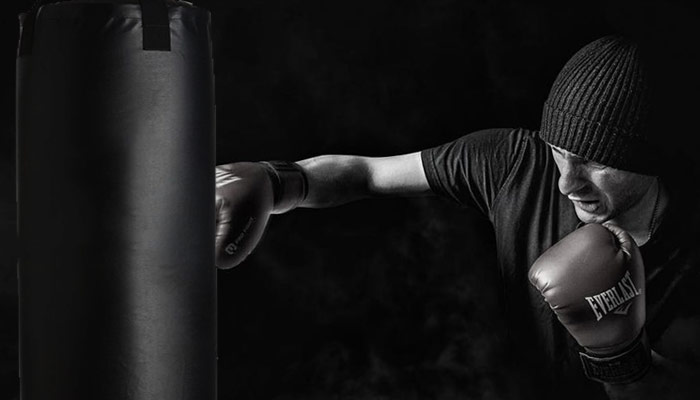I’ve always learned martial arts in a school or gym, but I get asked by beginners “What’s the easiest martial art to learn at home?” The simple answer is boxing. These days there are many tools online that will help you at least learn the basics of boxing at home.
Anyone who doesn’t think boxing is a martial art is kidding themselves. It’s called the sweet science for a reason. Boxing is an incredibly technical and intricate art. There are so many different techniques, setups, and counters that take years to master.
Why is Boxing easier to learn than other martial arts?
First of all, there are many nuances to boxing that you won’t be able to learn at home. Even though you are only using your hands it is incredibly complex and nuanced combat sport. With that said, in my opinion, here are the benefits for beginners just starting out:
- There are only really four very basic punches (and their variations) that you need to learn to get started.
- You only have to worry about your hands to start.
- You don’t have to worry about throwing elbows, kicks, or knees like in other martial arts.
- You also don’t have to worry about grappling, takedowns, or throws.
- Solo drills on the heavy bag and shadowboxing are core components of boxing training
It’s a very popular martial art and you can learn the basics in the techniques section of TSK or on YouTube
Pros and Cons of Self-taught Training
There are many pros to learning boxing at home. First, if you’re a beginner you can look like an idiot without anyone else watching. Some of you are less coordinated than others and in the privacy of your own home, you’re free to make mistakes without being embarrassed.
It’s also cheaper to do. At home, you can earn basic techniques without paying gym fees. If you do decide to join a gym in the future you can jump into advanced or intermediate classes right away.
If you’re doing martial arts to get fit, you can burn a lot of calories and lose weight boxing. Once you learn some basic combos you can mix it up and shadowbox or work the heavy bag for as long as you want and burn those sweet sweet calories. Do some bodyweight calisthenics in between rounds for the exponential burn.
There are also some cons to training at home. The first is form. It takes 10,000 hours of focused and guided practice to become an expert at something. Unless you’re getting someone to check your form, you might be training yourself some bad habits like dropping your guard. To minimize this you can use a mirror, get an online coach to do video calls with, or record yourself and ask people on reddit to check your form.
As I mentioned above there are many nuances to boxing that you can’t learn while training on your own. You can learn enough to get started but micro-movements like footwork, angles, rolling, slipping can be hard to get without a coach.
Next is injuries. If you somehow injure yourself while you’re alone, depending on the severity, things can be bad for you. As long as you’re not being a complete idiot this one shouldn’t be a problem, but I’ve seen some pretty hilarious fail videos of those same idiots.
How to Start Boxing at Home (the Easy Way)
Check out the basic techniques section to get started with boxing. You should start by learning your boxing stance and how to move around. Next learn the four basic punches: jab, cross, hook, and uppercut.
You can also check out YouTube for tutorials for some basic combos, dodging and blocking techniques. This should be enough to get you started on shadowboxing, which I think is a really good skill to improve your technique and confidence. Use a round timer app on your phone and do some rounds of shadowboxing every training session.
You can get a skipping rope to help you with footwork and rhythm. I’d also suggest getting gloves, wraps, and a heavy bag if you really want to take it to the next level.
A typical workout will consist of:
- cardio warm-up such as a brief jog, bike, or skipping to get your heart rate going
- mobility drills and exercises to further loosen up
- three-five 2-minute rounds with 30-second rests of shadowboxing
- 20-30 minutes focusing on learning or practicing a specific technique or drill
- five 2-minute rounds with 30-second rests of boxing on the heavy bag (you can add some core exercises like crunches in between rounds)
- 10 minutes of slower cool-down shadow boxing and stretches
Benefits of Training with a Partner
I would highly recommend finding a training partner if possible. If you’re up for the social interaction a training partner can help!
Your training partner can hold pads or the bag for you and check your form while you do techniques. There are also a lot of live drills you can do with a partner. With a partner, you’ll be able to work defence which you wouldn’t be able to do otherwise. It’s still possible to do different blocks on your own, but it’s harder to block with no on punching at you.
He or she will help keep you accountable and motivated to get your workouts if they’re a good partner.
That’s really all you need to get started. Once you have the basics down consider jumping into a gym setting where you can learn more from a coach and always have partners on hand to train with. After boxing, I’d also suggest learning muay thai for the kicks, knees, elbows and clinching.




